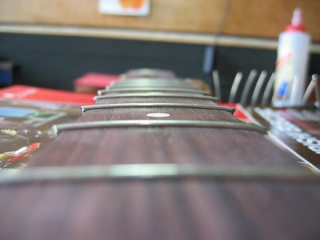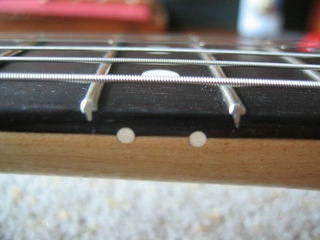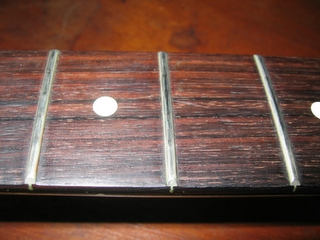
The frets on this mongrel Strat are slightly worn but the owner would like to have the neck completely re-fretted. The subject guitar has a Fender American Standard neck and a Japanese body.
The frets are removed and thank God there wasn’t any major chips along the fret slots. It takes patience and experience to remove the frets cleanly without major chipping. Most of the time, one does experience some chips along the fret slot, I just got lucky this time.
Is this the same fingerboard as above??? Yes it is. It looks brand spanking new doesn’t it? Over the years, I’ve developed a special treatment to the fingerboard immediately after the frets are removed to strengthen the integrity of the fret slots so they’re good as new!
The fingerboard is then perfectly finish sanded, fret slots cleaned up and re-cut if necessary. We’re now ready to fret. Thanks to the both intensive and extensive prep work, a very light fret dressing is usually required or in some cases, no dressing is needed.
I personally feel it defeats the purpose to re-fret a neck when the new
frets are dressed too excessively. Most mass produced guitars have their
frets dressed too much. Slightly more than 1/4 of the fret height is sanded
away on most mass produced guitars. You’re taking away at least
a year of play when that happens. One of the reasons is due to inexperience
and because the fingerboard was not perfectly leveled before fretting
thus the frets are not level with one another.

Halfway through the fret job. I use several methods to seat the frets properly in the slots. I usually hammer the frets in but there’re occasions where I seat the frets with a special tool.
Close up of the seated frets.
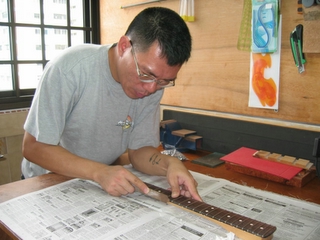
Here I am filing the fret ends flush. I personally prefer not to bevel the fret ends too much and that leaves more room for vibrato on the high E string.
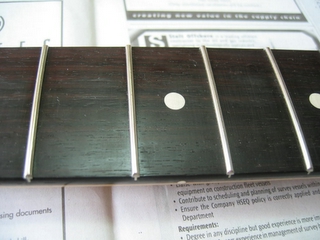
The frets are very lightly dressed and I’m very careful to just take off just what’s necessary. Just think about it, the more the frets are dressed, the sooner you need a fret dress or re-fret. After dressing, the frets are carefully crowned and perfectly rounded.
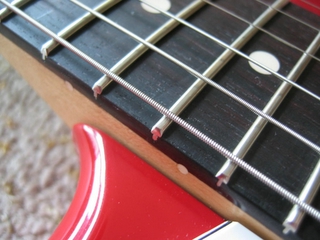
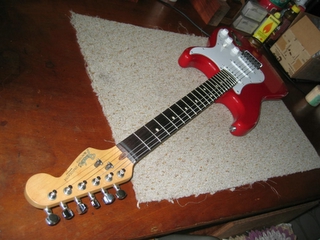
The guitar’s completely re-fretted, set up and waiting for the owner to come pick her up.
Here’s the customer’s comment for this guitar.
Hello Malcolm,
Thank you for the excellent job on my Strat. You have even fixed
the neck alignment problem even though I did not bring it to your attention.
You see, back in 1994, I saw this American Standard neck at a music shop
in Plaza Singapura. I tried to replace it myself and realised that the
alignment was off because the high E string almost falls off the fingerboard.
I lived with it for a while because at that time I wasn't aware of any
repair shop in Singapore. Later a colleague told me to send it to a basement
shop at Cuscaden Road to fix it. They "fixed" it all right and
charged me eighty bucks for it. The problem was still there and all they
did was to lower the action and make me wait for two weeks!! Thanks for
restoring my confidence. The new #155 frets are perfect and this guitar
has never played or looked better. I wish I had known you earlier to be
able to avoid all those crooks masquerading as "qualified repairmen".
It may not mean a lot to you, but this axe has great sentimental value
to me as I bought it with my first paycheck from the Army. It's a joy
to play and I'm using it regularly now thanks to your superb fret-work
and set-up. At the rate I'm going, it will probably need another re-fret
next year!
Ewen - April 2005


